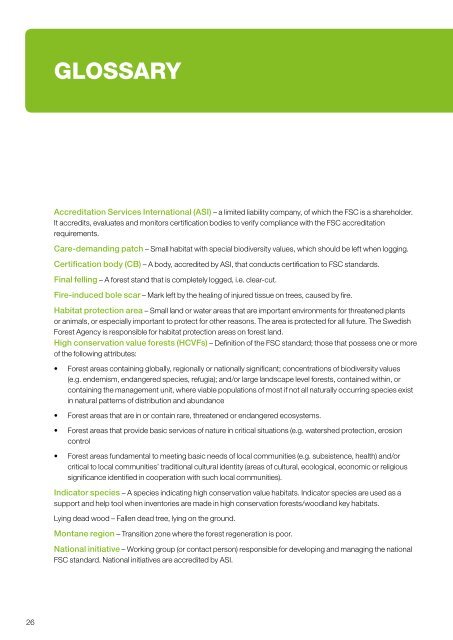Under the Cover of Forest Certification - Greenpeace
Under the Cover of Forest Certification - Greenpeace
Under the Cover of Forest Certification - Greenpeace
You also want an ePaper? Increase the reach of your titles
YUMPU automatically turns print PDFs into web optimized ePapers that Google loves.
GLOSSARY<br />
Accreditation Services International (ASI) – a limited liability company, <strong>of</strong> which <strong>the</strong> FSC is a shareholder.<br />
It accredits, evaluates and monitors certification bodies to verify compliance with <strong>the</strong> FSC accreditation<br />
requirements.<br />
Care-demanding patch – Small habitat with special biodiversity values, which should be left when logging.<br />
<strong>Certification</strong> body (CB) – A body, accredited by ASI, that conducts certification to FSC standards.<br />
Final felling – A forest stand that is completely logged, i.e. clear-cut.<br />
Fire-induced bole scar – Mark left by <strong>the</strong> healing <strong>of</strong> injured tissue on trees, caused by fire.<br />
Habitat protection area – Small land or water areas that are important environments for threatened plants<br />
or animals, or especially important to protect for o<strong>the</strong>r reasons. The area is protected for all future. The Swedish<br />
<strong>Forest</strong> Agency is responsible for habitat protection areas on forest land.<br />
High conservation value forests (HCVFs) – Definition <strong>of</strong> <strong>the</strong> FSC standard; those that possess one or more<br />
<strong>of</strong> <strong>the</strong> following attributes:<br />
• <strong>Forest</strong> areas containing globally, regionally or nationally significant; concentrations <strong>of</strong> biodiversity values<br />
(e.g. endemism, endangered species, refugia); and/or large landscape level forests, contained within, or<br />
containing <strong>the</strong> management unit, where viable populations <strong>of</strong> most if not all naturally occurring species exist<br />
in natural patterns <strong>of</strong> distribution and abundance<br />
• <strong>Forest</strong> areas that are in or contain rare, threatened or endangered ecosystems.<br />
• <strong>Forest</strong> areas that provide basic services <strong>of</strong> nature in critical situations (e.g. watershed protection, erosion<br />
control<br />
• <strong>Forest</strong> areas fundamental to meeting basic needs <strong>of</strong> local communities (e.g. subsistence, health) and/or<br />
critical to local communities’ traditional cultural identity (areas <strong>of</strong> cultural, ecological, economic or religious<br />
significance identified in cooperation with such local communities).<br />
Indicator species – A species indicating high conservation value habitats. Indicator species are used as a<br />
support and help tool when inventories are made in high conservation forests/woodland key habitats.<br />
Lying dead wood – Fallen dead tree, lying on <strong>the</strong> ground.<br />
Montane region – Transition zone where <strong>the</strong> forest regeneration is poor.<br />
National initiative – Working group (or contact person) responsible for developing and managing <strong>the</strong> national<br />
FSC standard. National initiatives are accredited by ASI.<br />
26

















